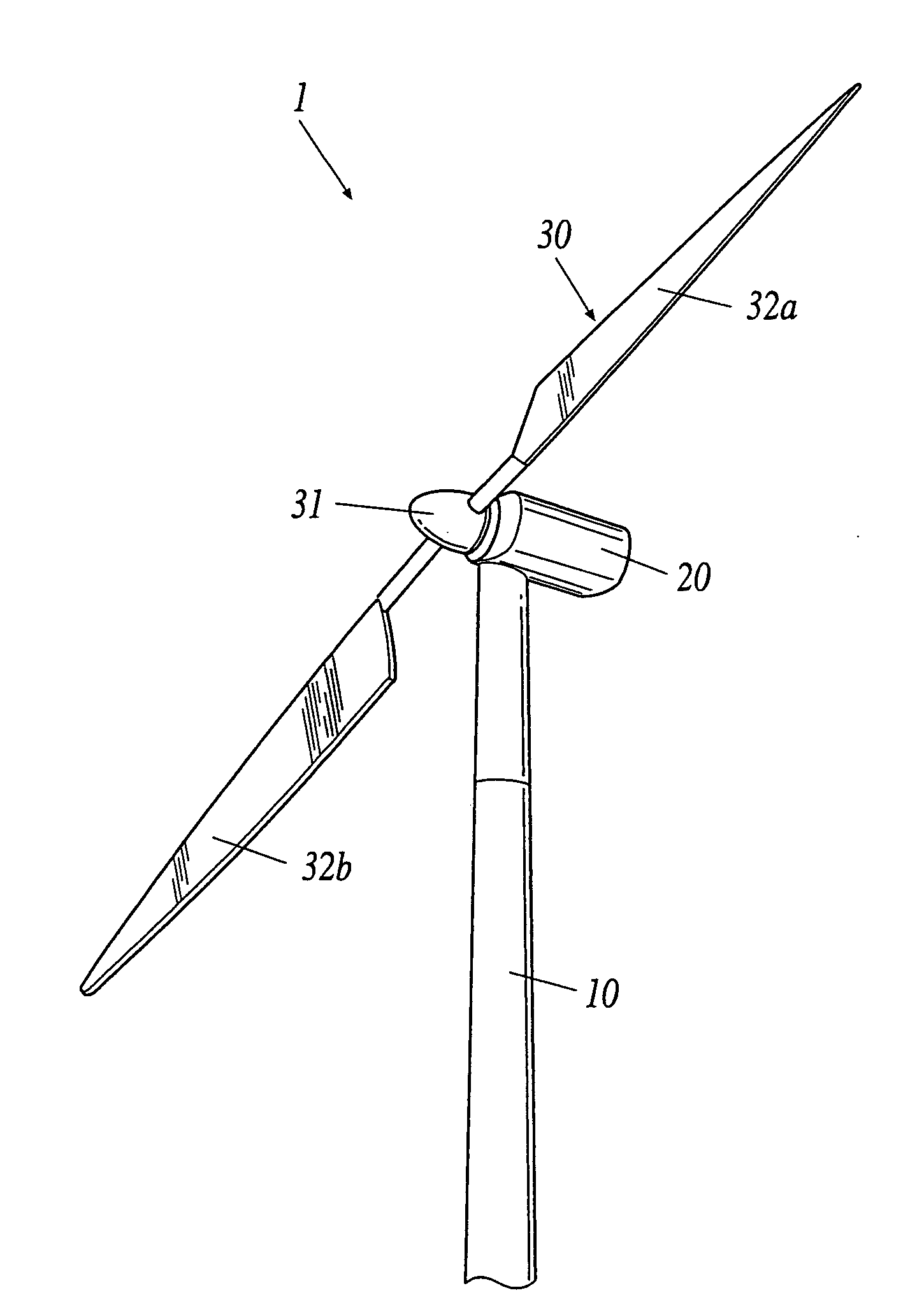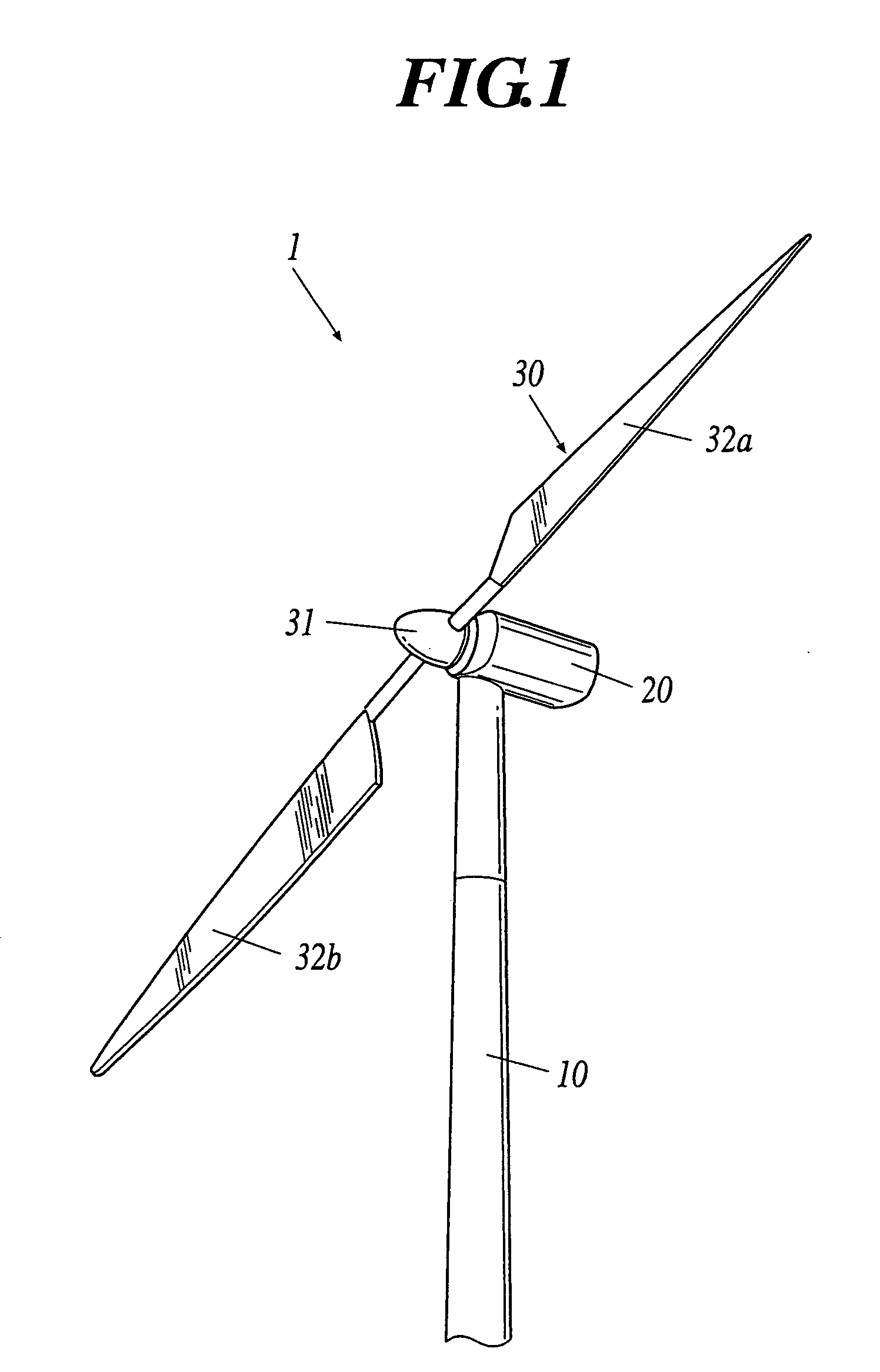Wind turbine generator
a wind turbine generator and vibration control technology, which is applied in the direction of electric generator control, machines/engines, mechanical equipment, etc., can solve the problems of increased cost, increased installation cost, and fluctuation of the rotor, so as to prevent the vibration of the windmill.
- Summary
- Abstract
- Description
- Claims
- Application Information
AI Technical Summary
Benefits of technology
Problems solved by technology
Method used
Image
Examples
first embodiment
[0038]Now, the first embodiment will be explained.
[0039]FIG. 1 is a perspective view showing the external appearance of a wind turbine generator 1 of the invention. The wind turbine generator 1 utilizes a horizontal axis wind turbine. The wind turbine generator 1 comprises a tower 10, a nacelle 20 disposed on the top of the tower 10, a main shaft (not shown) supported by and extending from the nacelle 20 in the approximately horizontal direction of the nacelle 20, blades 32a and 32b attached to the main shaft through a hub 31.
[0040]In the nacelle 20, various machinery such as a generator, a gear box, a control device and the like are installed. The nacelle 20 is rotatably disposed on the top of the tower 10.
[0041]A rotor 30 has the hub 31 attached to an end on the main shaft, and the two blades 32a and 32b attached to the hub 31. The windmill with two blades is shown just as an example; any number of blades will be appropriate. In the hub 31, a pitch drive device is located to drive...
second embodiment
[0055]Next, the second embodiment will be explained. The present embodiment is operable, as the first embodiment described above, with the structure shown in FIGS. 1 and 2. It is sufficient for the analyzer 6a to analyze and output only the frequency.
[0056]In the embodiment, the following vibration control is performed. FIG. 5 is a flow chart of vibration control of the embodiment. When the signal outputted by the vibration sensor 5 exceeds a predetermined threshold (step B1), the analyzer 6a analyses the frequency of the vibration based on the signal outputted by the vibration sensor 5, to output the signal and the analysis result to the control device 4a (step B2). When controlling to cause fluctuation regarding the rotor 30 such as changing the load of the generator 2, changing the pitch angle of the blades, the control device 4a determines the control value of the generator 2 and / or a pitch drive device 3 so as to avoid fluctuation of the rotor 30 at the frequency analyzed by th...
third embodiment
[0059]Next, the third embodiment will be explained. The present embodiment is operable, as the first embodiment described above, with the structure shown in FIG. 1. FIG. 6 is a block diagram of a control system. The rotor 30, the generator 2, the pitch drive device 3, and the vibration sensor 5 are identical with those in the first embodiment, while a control device 4b and an analyzer 6b are different from those in the first embodiment.
[0060]The analyzer 6b in the present embodiment is for analyzing the phase of the vibration component detected by the vibration sensor 5; the analyzer 6b receives the signal outputted by the vibration sensor 5, performs phase analysis based on real-time measurement, and outputs the signal outputted by the vibration sensor 5 together with the analyzed phase to the control device 4b.
[0061]The control device 4b includes a frequency setting section 7. The frequency setting section 7 is disposed in a storage device provided in the control device 4b. The f...
PUM
 Login to View More
Login to View More Abstract
Description
Claims
Application Information
 Login to View More
Login to View More - R&D
- Intellectual Property
- Life Sciences
- Materials
- Tech Scout
- Unparalleled Data Quality
- Higher Quality Content
- 60% Fewer Hallucinations
Browse by: Latest US Patents, China's latest patents, Technical Efficacy Thesaurus, Application Domain, Technology Topic, Popular Technical Reports.
© 2025 PatSnap. All rights reserved.Legal|Privacy policy|Modern Slavery Act Transparency Statement|Sitemap|About US| Contact US: help@patsnap.com



